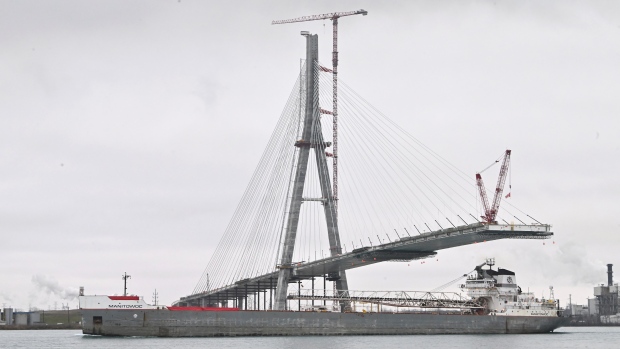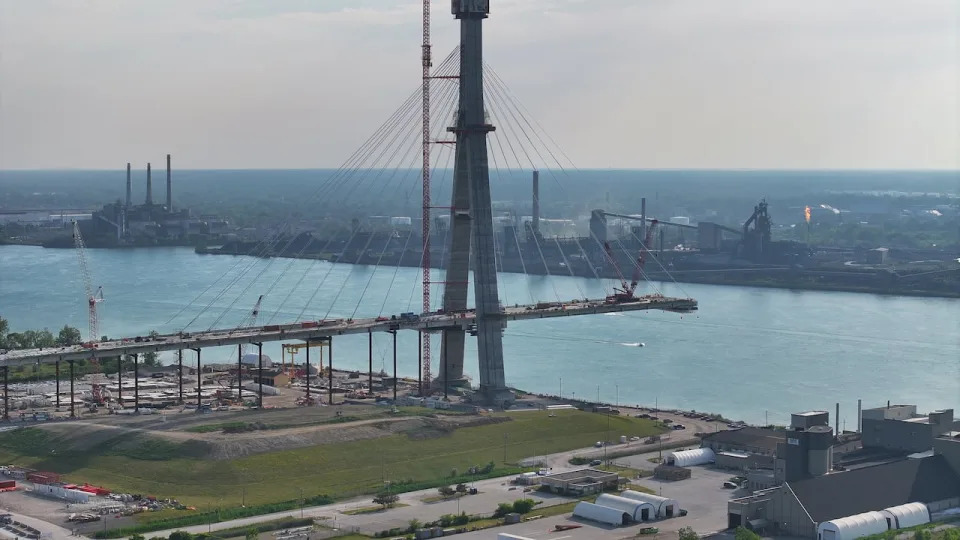New bridge connecting Detroit to Canada
won't open until fall 2025
The Associated Press

DETROIT — A second bridge connecting Detroit and Canada over the Detroit River won't open for travel until fall 2025, months later than anticipated, officials said Thursday.
Officials cited construction disruptions in the U.S. and Canada related to the COVID-19 pandemic.
The Gordie Howe International Bridge, named for a Canadian who played hockey for the NHL's Detroit Red Wings, began in 2018 and was last scheduled to be completed in 2024.
The target now is September 2025, though the bridge deck should be finished this year.
"Our project team is pleased that the impact to the construction schedule is limited to only 10 months beyond the original contracted completion date," said Charl van Niekerk, chief executive of the Windsor-Detroit Bridge Authority.
The project carries a price tag of $6.4 billion, up from $5.7 billion.
The Howe bridge will join the privately owned Ambassador Bridge as the second span connecting Detroit and Windsor, Ontario.
The Ambassador Bridge is considered the busiest U.S.-Canadian border crossing, carrying 25 per cent of all trade between the two countries. It plays an especially important role in auto manufacturing.
Canadian government will foot extra $700M
in Gordie Howe bridge delays
CBC
Thu, January 4, 2024
Crews work on the Canadian side of the Gordie Howe International Bridge in July. (Patrick Morrell/CBC - image credit)
The Gordie Howe International Bridge is now slated to open in September 2025, a delay of 10 months from its original targeted completion date in 2024.
The new targeted opening date means the international border crossing will now cost $6.4 billion Cdn, up from the original $5.7-billion cost estimate — a cost that will be borne entirely by the Canadian government, a Windsor-Detroit Bridge Authority spokesperson said.
"The project is still entirely funded by the Government of Canada," said Heather Grondin, the chief relations officer for the Windsor-Detroit Bridge Authority (WDBA). "So that does include this increase in the contract value."
Bridging North America, the private-sector partner on the project, would only absorb costs like fluctuations in the exchange rate or construction increases that are not caused by an unplanned event like the pandemic, Grondin said.
The new international border crossing was scheduled to be completed in November but "experienced unprecedented disruptions as a result of the COVID-19 global pandemic," the bridge authority said in a press release issued Thursday morning.
"The disruptions were even more prevalent for the Gordie Howe International Bridge project given the differing applicable restrictions in the U.S. and Canada, combined with the ramping up of construction activities in early 2020," the statement reads.
The bridge authority says the contract between the Windsor-Detroit Bridge Authority (WDBA) and Bridging North America (BNA) has been updated to reflect the new completion date.
Grondin says the increased project cost will not impact the eventual toll to use the bridge — instead the government will just take longer to recoup its costs on the project via tolls.
The first vehicles are expected to cross the bridge in fall 2025. Last year was "the busiest construction year to date" on the project, the bridge authority says.
The delay comes with a one-year extension to the bridge's community benefits plan worth $3 million Cdn that will be split between Canada and the United States over the 2025-26 fiscal year.
In 2023 the bridge towers reached their full height of 220 metres. Grondin says the bridge itself will finally meet in the middle over the Detroit River this summer — but that does not mean the bridge will be ready to open.
The news was initially shared by Windsor West MP Brian Masse on Facebook late Wednesday night.
"We're doing this to improve the conditions in our community that have been really difficult to deal with," Masse told CBC News. "Getting $3 million for community benefits is a plus and it really does make a difference because we'll now have to wait a little longer, but at the same time we'll see some improvements in our community and that's the important part."
Mary Ann Cudderman is a business owner in Sandwich, the neighbourhood where the Canadian portion of the bridge is located, and sits on the committee advising on the bridge's community benefits plan.
"It's a little disappointing to tell you the truth. I think we're all looking forward to this new bridge here in this area and getting construction over with and done," Cudderman said. "But I think we can understand the challenges they have met especially with COVID."
Proceeds from the community benefits plan are awarded to non-profit organizations. Cudderman says personally she'd like to see funds address children's issues and poverty in the area.
"We're really looking forward to having this new bridge and having these community benefits," Cudderman said. "I think anyone that crosses the bridge is looking forward to the bridge being built.
"We need it."

No comments:
Post a Comment